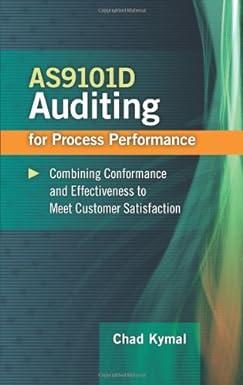Question
A PROBLEM OF PRICE Sue Jones sat at her desk reflecting on a pricing problem. Sue was a graduate of State University, where she majored
A PROBLEM OF PRICE
Sue Jones sat at her desk reflecting on a pricing problem. Sue was a graduate of State University, where she majored in materials management. Since joining the small manufacturing firm of Prestige Plastics in Des Moines, she had been promoted from assistant supply manager to supply manager. She was responsible for buying the chemicals used in producing the firms plastic products. Sue was really perplexed by a particular procurement involving the purchase of X-pane, a chemical that was formulated specifically for Prestige Plastics. Thirty-one days ago, she forwarded a request for bids to six suppliers for Prestiges estimated annual requirement of 10,000 drums of X-pane. Yesterday morning, Sue opened the five bids that had been received. The bids, F.O.B. Des Moines, were as follows: Total price ($) (for estimated annual Price per requirement of drum ($) 10,000 drums) Greater Sandusky Chemical 312 3,120,000 Chicago Chemical Co. 297 2,970,000 Tri-Cities Chemical 323 3,230,000 St. Louis Industries 332 3,320,000 St. Paul Plastics 340 3,400,000 The Chicago Chemical Company was low bidder for the fifth straight year. On the face of it, a decision to award the annual requirements contract to Chicago Chemical looked obvious. The day after the bid opening, the sales engineer from Greater Sandusky Chemical threw Sue a ringer. He said that no one would ever be able to beat Chicago Chemicals price. His firm estimated that setup costs associated with producing X-pane would be approximately $750,000. He went on to say that due to the uncertainties of follow-on orders, his firm would have to amortize this cost over the one-year period of the contract to preclude a loss. Sue checked with the other unsuccessful bidders. They said substantially the same thing: $700,000 to $850,000 in setup costs were included in their prices. Next, Sue looked at the history of past purchases of X-pane. She saw that on the initial procurement five years ago, Chicago Chemicals bid was $202 per barrel, $3 lower than the second lowest price. Since that time, bid prices had increased, reflecting cost growth in the materials required to produce X-pane. Each year, Chicago Chemicals prices were $3 to $15 per drum lower than those of the unsuccessful competitors. Sue knew from her supply management course at State University that when five prerequisites were satisfied, under most conditions, competitive bidding normally resulted in the lowest price. She also knew that it was important to maintain the integrity of the competitive bidding process. But Sue felt a strong sense of uneasiness. Something did not seem right.
Present a good cost analysis of the situation in the case. Describe 3 approaches to overcoming Sues pricing problem. Support with a quantitative analysis.
Step by Step Solution
There are 3 Steps involved in it
Step: 1

Get Instant Access to Expert-Tailored Solutions
See step-by-step solutions with expert insights and AI powered tools for academic success
Step: 2

Step: 3

Ace Your Homework with AI
Get the answers you need in no time with our AI-driven, step-by-step assistance
Get Started


